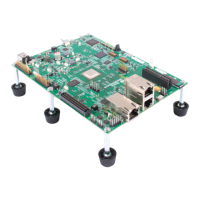Hardware Interrupts
4-18
DSP/BIOS has some code segments that need to be protected from
interrupts; these code sections are called critical sections. If these segments
are interrupted, and interrupt calls some DSP/BIOS API, it is bound to corrupt
the program results. Therefore, it is important to surround the code with SET
INTM, DBGM and CLRC INTM, DBGM.
Figure 4-2 shows two code examples of regions protected from all interrupts.
Example 4-2. Code Regions That are Uninterruptible
(a) Assembly Code
(b) C Code
Using HWI_restore instead of HWI_enable allows the pair of calls to be
nested. If the calls are nested, the outermost call to HWI_disable turns
interrupts off, and the innermost call to HWI_disable does nothing. Interrupts
are not reenabled until the outermost call to HWI_restore. Be careful when
using HWI_enable because this call enables interrupts even if they were
already disabled when HWI_disable was called.
Note:
DSP/BIOS kernel calls that can cause task rescheduling (for example,
SEM_post and TSK_sleep) should be avoided within a block surrounded by
HWI_disable and HWI_enable since the interrupts can be disabled for an
indeterminate amount of time if a task switch occurs.
.include hwi.h55
...
HWI_disable A ; disable all interrupts, save the old intm
value in reg A
’do some critical operation’
HWI_restore A0
.include hwi.h
Uns oldmask;
oldmask = HWI_disable();
’do some critical operation; ’
’do not call TSK_sleep(), SEM_post, etc.’
HWI_restore(oldmask);

